Industrial IoT: Creating New Business OpportunitiesIndustrial IoT: Creating New Business Opportunities
While the consumer IoT putters along, the industrial world is diving headlong into using connected devices. Here's how mining equipment maker Joy Global plans to use near real-time remote analytics to squeeze more productivity out of equipment.


6 Internet Of Things Building Blocks
6 Internet Of Things Building Blocks (Click image for larger view and slideshow.)
Joy Global's mining shovels are so massive that a good operator can load 400 tons of earth into a dump truck with just three swings. In the Internet of Things (IoT) world, that digging equipment is also kicking off two gigabytes of data every eight minutes.
And if a shovel operator takes four scoops to fill the truck? Thanks to all that data, Joy Global, by late April, plans to be able to spot that extra scoop within 10 seconds from a monitoring center more than 6,000 miles away from the mine site. The company will alert the mine's manager, who can figure out the problem and get that shovel operator back working at peak capacity.
Joy Global's plans point to what will become a rising arena of competition around IoT: Optimizing the performance of machines and the people who run them, in near real-time, and not just predicting and preventing things like when a machine might break down.
"We'll be able to do, from 6,000 miles away, what we're able to do today at the mine site," said Joy Global CIO Mark Shaver, discussing the initiative at the Fusion CEO-CIO Symposium in Madison, Wis., on Wednesday. "Within 10 seconds, we'll be able to say that the operator of that machine is not running at top efficiency."
Joy Global sells the Joy and P&H brands of mining equipment. The company's roots go back more than 100 years. Now, the company's expanding into a new, technology-enhanced service offering it calls JoySmart Solutions, developed in a partnership with IBM. It's all part of what Shaver called the company's "smart, connected mine" strategy.
[ Want to discuss IoT strategy with C-level peers? Come to the information Conference April 27 and 28 in Las Vegas. ]
Joy Global plans to have two mine sites, one in Africa and one in Australia, using the JoySmart near-real-time analysis platform in April. It expects a mine near the Arctic Circle in Norway to be using the service later this year.
While the consumer IoT putters along, the industrial world is diving headlong into using connected devices. So far, the business case often has relied on predictive maintenance: Monitor equipment, predict that a failure is looming, and fix it before a breakdown. Preventative maintenance remains a big part of Joy Global's services, since a broken piece of machinery can cost a mine $1,200 to $6,000 a minute. But optimizing performance could be an even more powerful IoT driver for makers and buyers of industrial machines.
Services are a growing part of Joy Global's business, as more companies choose to pay for equipment use as an ongoing service, rather than to buy equipment as a capital cost. That model puts the pressure on equipment companies to keep their machinery running at a peak level, so analytics and monitoring like this become increasingly important.
According to Shaver, Joy Global had been doing monitoring and analytics on site. He said the company chose to partner with IBM to develop JoySmart Solutions because it didn't feel its existing systems would scale to the near real-time, global model that it needed. The company also wanted to go beyond maintenance alerts for more in-depth analysis of performance.
In addition to optimizing performance, Joy Global also makes a safety case for using remote analysis services. It has a product that supports the roof and walls of a mine, for instance, called longwall systems, that can have 8,000 sensors along a face assessing whether or not the equipment is adjusted and functioning properly. If those sensors can spot a problem, "then we're going to take some people off the face, and we're going to take them out of harm's way," Shaver said. "That's where we're headed. And we're going to do it from 6,000 miles to 8,000 miles away."
Attend Interop Las Vegas, the leading independent technology conference and expo series designed to inspire, inform, and connect the world's IT community. In 2015, look for all new programs, networking opportunities, and classes that will help you set your organization’s IT action plan. It happens April 27 to May 1. Register with Discount Code MPOIWK for $200 off Total Access & Conference Passes.
About the Author
You May Also Like






